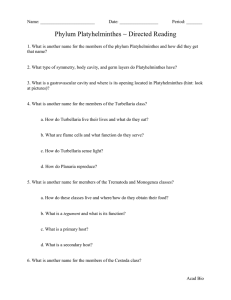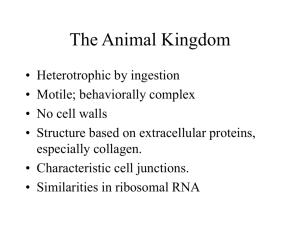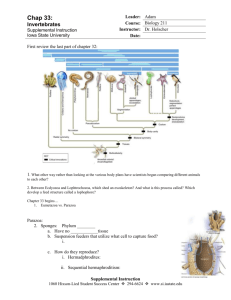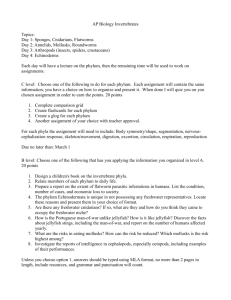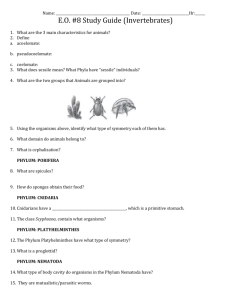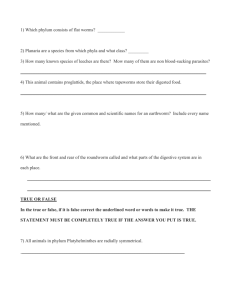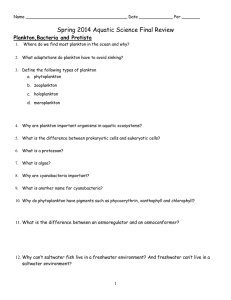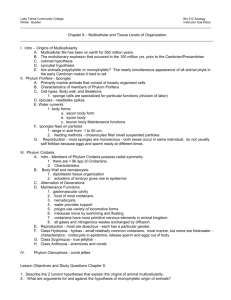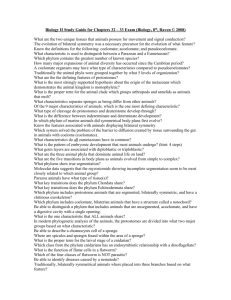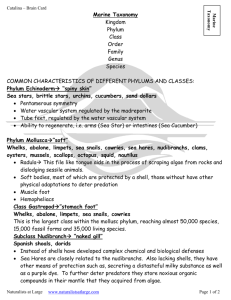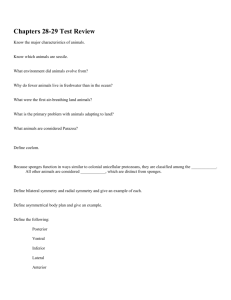Porifera, Cnidaria, Worms
advertisement
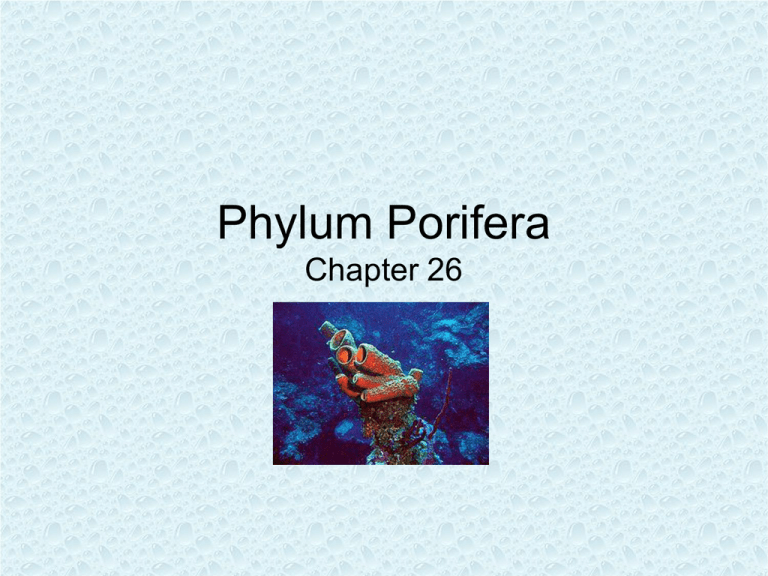
Phylum Porifera Chapter 26 General Characteristics • • • • • • • No mouth, gut, specialized tissues or organ systems Multicellular Kept rigid through deposits of calcium carbonate, silica or spongin Reproduce asexually through budding and/or sexually through sperm and egg Water enters through the central cavity, deposits nutrients, and leaves through a hole called the osculum (filter feed) sessile majority are marine (salt water) species, ranging from tidal zones to depths exceeding 8,800 metres Gemmules • When conditions deteriorate, for example when temperatures drop, many freshwater species and a few marine ones produce _______________, • “survival pods,” of unspecialized cells that remain dormant until conditions improve and then either form completely new sponges or re-colonize the skeletons of their parents. Ecological Importance • Environmental >____________________________________ • Economical >____________________________________ • Medicinal >___________________________________ ____________________________________ Phylum Cnidaria General Characteristics • • • • • • • • • Have a mouth and gastrovascular cavity with digestive enzymes Lacks an _______________(excretory system) and _______________________ Simple nervous system (nerve nets and sensory cells – statocysts and ocelli) Soft bodied with stinging tentacles around their mouth Carnivores (capture prey with their nematocysts) Asexual reproduction: _________________ Sexual reproduction occurs in medusa form (depending on the species, fertilization is external – chance encounter or inside an egg-carrying medusa) Two Body Forms 1. Polyp – sessile flowerlike 2. Medusa – motile bell-shaped Depending on the type of cnidarian, their life cycle may include both body types. Three Classes of Cnidarians 1. ___________________ -size: few cm to a metre -freshwater -polyp and short medusa phase -usually separate sexes, but a few are hermaphroditic ex: hydras Portuguese Man-of-War Three Classes of Cnidarians 2. ____________________ -medusa is large and long-lived -polyp is a tiny larval stage -can grow up 2m in diameter -most nematocysts are harmless to humans ex: Jellyfish Three Classes of Cnidarians 3. _________________ -polyp stage only -many shallow water species depend on photosynthetic symbiotic relationships -can grow up to 1m ex: sea anemones and corals Ecological Importance • • • • Unsegmented Worms Phylum Platyhelminthes and Phylum Nematoda General Characteristics • _____________________ • _____________________ • Simple nervous system with sensory organs and a simple brain in their anterior region (head) • Has 3 germ layers (ectoderm, mesoderm and endoderm) Phylum Platyhelminthes (Flatworms) -Carnivores that feed on tiny aquatic animals, scavengers feeding on recently deceased animals, or parasites feeding on blood or tissue fluids inside their hosts body -Use a pharynx to suck food into a gastrovascular cavity -Undigested food is expelled through the mouth (____________________________) -Lack a specialized circulatory and respiratory system. Depend on diffusion to transport oxygen and nutrients to their tissues and wastes out -Have light sensitive organs ( ____________________) Examples: >Class Turbellaria: __________________________ >Class Trematoda: __________________________ >Class Cestoda: ____________________________ Phylum Nematoda (Roundworms) • Have a ____________ and an ______________ • Simple nervous system • Bilateral symmetry • Free-living • Mostly carnivorous • Breathe and excrete their wastes through their body walls via diffusion • Reproduce ___________ Ecological Importance • Mostly negative – disease causing in humans and animals – Example: Trichinella, elephantiasis, Ascaris, etc. Your Task: read and make notes pages 570-578 answer questions #1-5 pg 578
